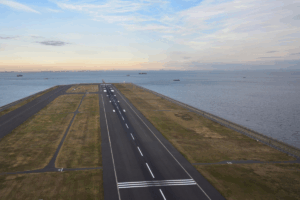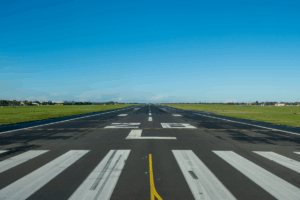极端天气条件可能在任何时间、任何地点发生,严重程度各不相同。恶劣天气对机场照明灯具、线路、控制设备和其他组件的影响可能会破坏正常运行,严重影响系统支持跑道和滑行道安全的能力。
虽然无法阻止极端天气的发生,但机场运营商可以采取措施帮助减轻对跑道照明系统的影响。不过,首先必须了解雪、沙、温度波动以及其他与天气相关的条件和事件会如何影响跑道照明基础设施。
极端天气如何影响机场跑道照明系统的性能?
人们可能不会想到,位于北方的机场与在沙漠中运行的机场面临着同样的天气威胁,但事实上,它们有一个共同的敌人:高速风。
风会将雪或沙子吹进机场照明系统的每个裸露缝隙,堵塞机械部件或使电气元件短路。此外,风吹起的雪和沙还会堆积在跑道信标前,影响其发出可见光的能力。
结冰也会引起关注,因为冰会积聚在镜头和线路上,可能会影响性能。春季解冻时,融化的冰水会渗入设备最微小的裂缝,损坏内部组件。在高湿度地区或沿海地区,水也会造成威胁,因为潮湿和含盐的空气会腐蚀金属,使敏感元件暴露在外界环境中。
气温波动剧烈的机场也存在风险。例如,夏季白天气温炙热,夜间气温零下的地区,其跑道照明设备的金属、塑料部件和电线绝缘层会发生膨胀和收缩。如果不加以控制,这些反复循环会导致系统部件出现裂缝,使电气连接容易受损。
设计系统时考虑极端天气条件
机场安全不容妥协,这就要求跑道照明系统必须始终可靠。您可以在系统设计阶段或改造过程中采取措施,通过了解当地环境并采取适当措施,使跑道照明系统在任何极端天气条件下都能可靠运行,从而保护设备免受损坏。
保护设备的策略包括
- 跑道灯采用 LED 技术,因为这种技术已被证明可在温度波动剧烈的气候条件下稳定可靠地运行
- 使用不锈钢、钛和钛合金、铝和铝合金以及镍基合金等耐腐蚀材料制成的五金件和配件,这些材料在含盐或潮湿的环境中能承受降解作用。
- 使用粉末涂料或专用涂料等保护性涂层,防止外部设备表面生锈
- 使用密封机箱,机箱设计有垫圈、密封件和排水槽等功能,可防止水渗入和冷凝水积聚,帮助您避免短路和设备故障。
阅读更多 升级机场跑道照明系统时的 5 个考虑因素
在恶劣气候条件下维护机场跑道设备
一旦您的耐候设备安装到位,就必须进行定期维护,以确保其持续提供可靠的性能。定期检查安装螺栓和联轴器的扭矩是否正确,并在暴风雨后检查设备是否有夹具移动、倾斜或移位的迹象。
必须定期对灯泡、透镜、电源线和其他组件进行目视检查,以确保一切正常。降雪量大或有沙尘暴的地区需要更频繁地进行维护,以清理灯具上的冰块、灰尘、沙子或其他可能影响光输出的碎屑堆积物。使用太阳能供电系统的机场也需要确保太阳能电池板没有障碍物。
以下是一些保护机场跑道设备的额外技术提示:
- 使用符合 FAA 标准的抗风灯具
- 认证装置: 确保所有照明灯具均获得 FAA 批准(根据 AC 150/5345 系列),并符合 FAA 第 67 号工程简报的风荷载额定值。
- 风荷载额定值: 固定装置应符合最低结构完整性标准(在某些应用中,时速通常超过 300 英里/小时)
- 低矮型灯具: 尽可能使用路面内灯具或低矮的高架灯具,以减少风的影响
- 加固安装系统
- 底罐和接头: 使用更深和/或更坚固的底罐和易碎接头,并适当拧紧和密封
- 锚固螺栓: 使用耐腐蚀硬件将固定装置牢固地锚定在混凝土垫或底罐上
- 螺纹锁: 在螺栓上使用螺纹锁固剂,以防止振动松动
- 正确使用易碎(可断开)支架
- 旨在 一击即中 如果受到撞击或应力,易碎联轴器可减少对安装系统的应力传递,同时最大限度地减少大风情况下的碎片
- 安装在 正确扭矩 以及 FAA 指南(AC 150/5340-30 系列)规定的高度
- 保护电缆和管道
- 直接埋葬或包埋: 使用直接埋入式额定电缆或将导管埋入混凝土/沥青中以防止暴露
- 应力消除器 添加松弛环或应力消除装置,以避免夹具在受力时移动或移位造成拉力损坏
- 密封连接: 确保防水连接,防止大风大雨后湿气侵入
- 加固关键基础设施
对于关键系统,如 REILs, PAPIs, ODALs和 风筒考虑一下:
- 抗风外壳 和支撑杆
- 电线 或在飓风易发地区进行内部加固
- 高架设备棚 用于电子产品
- 喷气爆炸和滑行道风切变设计
- 战略布局: 尽可能将照明灯置于已知喷气爆炸区之外。
- 防爆盾或护堤 如果暴露在空气中不可避免,则应安装屏障来改变气流方向。
- 使用系绳固定临时固定装置: 对于便携式照明灯,应使用适当的支架和锚定系统
- 地区考虑因素
- 在 飓风区, 遵循国际民航组织和美国联邦航空局关于四级或五级风载荷的指导方针
- 使用 当地风荷载规范 (如 ASCE 7 或 IBC 标准),以确定安装规格
阅读更多 嵌入式跑道和滑行道照明系统的维护程序
帮助您保持高效运营的先进技术
您还可以通过安装先进的技术(如 L-890 机场照明控制和监测系统.该工具不仅能对跑道照明系统进行远程控制,还能对组件进行实时监控,在出现潜在故障时提供广泛的警报和报告功能。这种积极主动的照明维护方法可帮助您在定期维护检查之间提前发现系统问题,从而提高运营的安全性。
通过一个 铁谐振电源.这些堆叠式装置可在极端工作条件下提供电力,而不受周围电力系统的影响。即使输入电压因电力不稳定或其他能源干扰而变化,其谐振电路也能确保输出电压恒定可靠。
了解更多保护机场照明设备免受恶劣天气条件损坏的有效策略、 联系 Airport Lighting Company 专家.我们将为您提供先进的技术解决方案,确保您的机场照明系统在未来数十年内发挥安全可靠的性能。
请致电 Airport Lighting Company,了解最新的机场照明技术
Airport Lighting Company 团队是 随时准备回答您的问题 了解我们的技术产品如何帮助您提高跑道的安全性、可靠性和效率。请致电 315-682-6460,我们将为您提供快速、友好的服务。


